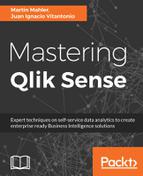There are significantly visible changes on the frontend in Qlik Sense compared to QlikView, but this section will cover most of the technical aspects of it:
- Alternate states: Alternate states are supported in Qlik Sense, as it's sitting on the same engine as QlikView. However, there is no supported way in the user interface to create alternate states or assign them to an object. There have been some extensions in Qlik branch, which are trying to support the direction. However, they have not been implemented robustly. Comparative analysis is one big beneficiary of alternative states, and it apparently suffers in Qlik Sense because of that. Alternate states can be used for sophisticated mashups and QAP projects, but in Qlik Sense alternate states are not available to be implemented via the user interface.
- Variables: Variables can be used in Qlik Sense as they were in QlikView. There are no significant differences between the two technologies, with the exception of limited possibilities to efficiently manage variables in Qlik Sense. It's still very technical; they can be loaded and declared via the script, but, for example, there is no smart way to delete multiple variables. They have to be removed one by one in the My Work area of Qlik Sense, which is time-consuming. At the same time, variables are not shareable objects and can hence not be created in a collaborative environment, for example, when the app has published on a stream or production node.
They can, however, be created dynamically in the script with some technical tricks (keep the loading script with variables on a shared .qvs file or maintain variables in an Excel spreadsheet) and then embedded in Master Key Measures. All in all, the support for variables is still there, but maintenance of them has degraded a bit.
An excellent blog about how variables can be used has been written by Henric Cronström at Qlik.com: https://community.qlik.com/blogs/qlikviewdesignblog/2013/11/04/the-magic-of-variables.
- Bookmarks: Bookmarks are an important feature of every frontend technology, as they allow the user to put down their bespoke view and selections of what they see to either come back to it at a later stage or to share it with other users. Bookmarks in QlikView have been a compelling feature, and they have also been implemented in Qlik Sense. But, while bookmarks can be created via both the user interface and via the API, they cannot be shared with other users, and this is a massive shortfall in Qlik Sense. Secondly, the options offered via the user interface in Qlik Sense are limited too. You can't decide whether you want to save variable values in bookmarks, if you wish to have the bookmark selections to be applied on top of current selections, or which sheet the bookmark should take you to, if at all. All in all, bookmark implementation at the time of writing is poorly implemented in Qlik Sense, and this limitation needs to be taken into account when designing a Qlik Sense app.
- Frontend functions: Due to the fact Qlik Sense is using the same QIX engine as QlikView, all frontend functions are working in Qlik Sense, too. There is, however, a list of expressions and functions which Qlik plans to take away in future versions, hence why they recommend avoiding using them as far as possible in new Qlik Sense apps.
The following list of recommended functions to avoid using will be changing over the course of time. Hence, it's recommended to always double check with the source at Qlik's documentation:
http://help.qlik.com/en-US/sense/3.1/Subsystems/Hub/Content/Scripting/functions-statements-not-recommended.htm.
http://help.qlik.com/en-US/sense/3.1/Subsystems/Hub/Content/Scripting/functions-statements-not-recommended.htm.
